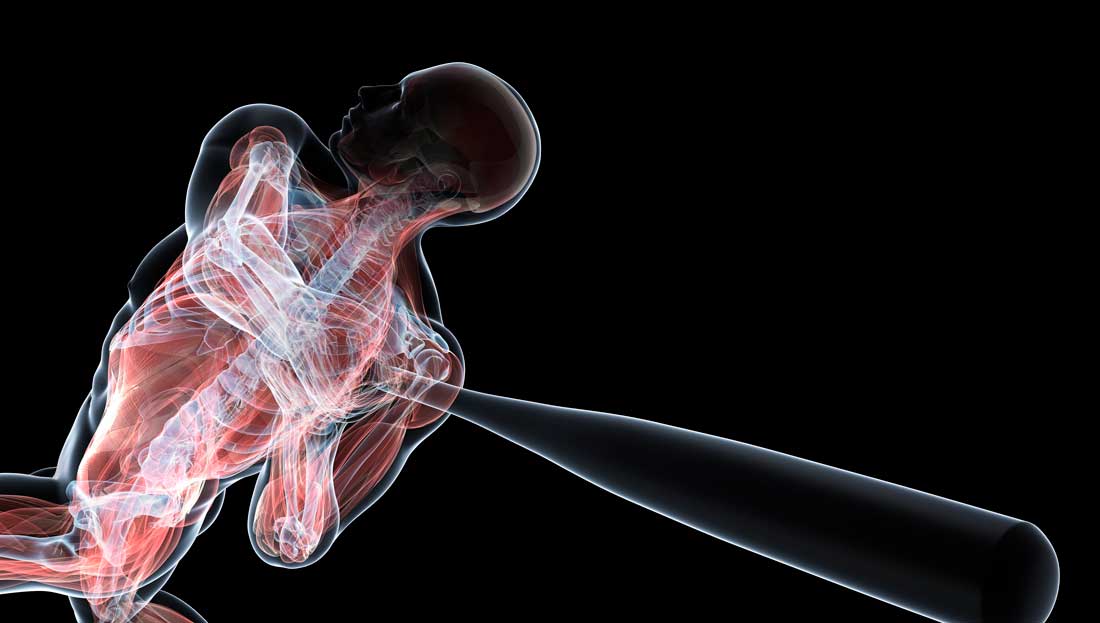
“Squeeze your core!”
“Stomach tight!”
“Brace your abs!”
Abdominal bracing cues like these are among those most commonly used in a fitness setting. These are so common, in fact, that little thought is given to their outcome or efficacy.
While core engagement is undoubtedly important, multiple strategies can elicit this outcome. The cues listed above tend to encourage an abdominal bracing strategy in which individuals produce large amounts of muscular force to stabilize the spine.
When used too often or in the wrong context, this strategy becomes problematic. This article explores the effectiveness of core bracing cues and offers alternatives for achieving spinal stability during movement and sport.
Suit of Armor
The intention behind cues like “brace the core” or “squeeze your abs” is to stabilize the spine and reduce the risk of injury. Because trainers and fitness instructors understand that the lumbar region is vulnerable to injury when unstable, they often take precautionary measures via abdominal bracing cues.
However, the effectiveness of a cue is not measured by the intended outcome, but by the movement strategy it evokes. When clients hear the terms “squeeze” or “brace” in reference to their core, the reaction is often to engage all of their local and global core muscles in a high-level contraction. While the local core muscles (such as the transverse abdominis and multifidi) are intended to work as spinal stabilizers, the appropriate function of the global core muscles (such as the rectus abdominis and oblique muscles) is to control and produce movement (Gibbons, 2001).
More muscle recruitment might sound useful, but in the case of functional core stability, it doesn’t result in efficient movement.
“Bracing as an isometric contraction will prevent normal movement when the zones [i.e., lower, middle and upper regions of the body] must move relative to each other,” says Joanne Elphinston, founder of JEMS Movement Systems. “Without this, we cannot use our myofascial relationships to store and release elastic energy, nor to use this system to help us dynamically stabilize,” she says.
Further, a high-load abdominal contraction can interfere with normal breathing, reduce the available movement and stifle the transmission of force. It is also an energy costly strategy (Elphinston, 2008).
“The [abdominal bracing] strategy can influence our postural stability by diminishing our multijoint options for absorbing and accommodating to postural sway, and influence the calibration of intra-abdominal pressure, which is a dance between diaphragm, pelvic floor and abdominals,” explains Elphinston. “If the abdominal wall is unyielding, the mechanism that adjusts this pressure as functionally appropriate is lost. Intra-abdominal pressure is one of our normal spinal-stabilizing mechanisms, so to alter its fine-tuned coordination with a blunt continuous contraction is problematic.”
Put simply, a continuous abdominal contraction limits your ability to dynamically stabilize and prohibits the transfer of force between the lower and upper extremities. This translates to a limited capacity to perform functional movements, whether they are activities of daily living or sport-specific exercises.
“If you want to run fluently or hit a golf ball—both low-load activities—bracing will interfere with normal movement by inhibiting motion between the upper and lower torso, altering breathing mechanics and costing you needless energy,” says Elphinston.
Elphinston describes something called the “suit of armor strategy,” which involves stiffening the large trunk muscles to create high levels of stability. This strategy is useful for high-threshold protection in the sense that it restricts movement, but becomes problematic when the intention is to move freely (Elphinston, 2008)
Is Abdominal Bracing Ever Useful?
Before you decry this article as heresy and throw out whatever it is you’re reading it on, let’s explore how and when abdominal bracing is beneficial. If we consider the previously mentioned outcomes of abdominal bracing, we can understand the movement contexts in which it is appropriate.
Bracing for Impact
Because abdominal bracing increases rigidity around the trunk, it is a useful strategy when preparing for impact.
“If you need a short, sharp burst of high-force support, bracing will be your go-to solution,” suggests Elphinston. This can occur with sports where physical contact occurs, such as football, soccer or rugby. Maintaining a rigid torso against an oncoming load serves to stabilize and protect the spine against impact.
Heavy Lifts Performed in a Single Plane
When performing maximal or near–maximal lifts that occur in a single plane of motion, such as the deadlift, bench press or squat, abdominal bracing is a useful way to increasing intra-abdominal pressure and reinforce intersegmental stability of the spine (Hackett and Chow, 2013). Experienced lifters often use the Vasalva maneuver to achieve this outcome, which involves inhaling prior to movement execution and holding your breath while lifting to create high amounts of rigidity in the trunk.
Note: The Valsalva maneuver should be avoided for those who have been diagnosed with hypertension or an abdominal hernia, as an increase in abdominal pressure may cause additional harm in these cases.
Beyond Bracing
Without cueing abdominal bracing, how can you help your clients achieve trunk stability and move safely?
In contrast to the suit of armor strategy described above, Elphinston proposes the elastic support strategy, which allows for unrestricted movement in the limbs and efficient force transmission. Walking and running are excellent examples of this strategy; both employ diagonal elastic support—a constant diagonal stretch and release created by counter body rotation. This makes movement extremely efficient, allowing for the storage and transfer of energy from one area of the body to another (Elphinston, 2008)
A similar strategy can be seen in other rotational movements such as golfing, throwing or swinging a bat. In these scenarios, force is not created in the core, but instead is transmitted through the core.
Elphinston also describes linear elastic support. Imagine creating a line of tension by raising the arms overhead and forcefully throwing a ball. Tension is created through the eccentric lengthening of the anterior chain and force is transmitted as it contracts.
Elastic Support Strategy in Action
Stand up and move as if preparing to pitch a baseball or swing a tennis racket. Notice the elongation of the muscles around your trunk as your spine rotates and the change in distance between your pelvis and ribs. Return to the starting position. Brace your abdominals and initiate a high-force abdominal contraction. Maintain this contraction while attempting to perform the same movement. Do you notice a difference? You’ll likely find that the rigidity of your torso limits your available movement in the second trial.
Stability Through Length
Another efficient strategy for creating spinal stability through movement is via lengthening rather than compression. Stability is not created by muscles; rather, it is generated by neuromuscular systems and myofascial relationships that involve appropriate motor patterns, which includes the timing, amount and sequencing of muscle activation (Elphinston, 2008).
To understand this concept, consider stable movement revolving around a central longitudinal axis (CLA). The CLA is not a fixed or rigid position, but a central line that supports appropriate multiplanar movement of the limbs. Elphinston describes the image of a thick cable running vertically from your head down through the middle of your body. This line remains connected even as you move through multiple planes and as the shoulders and pelvis change position. Imagine pulling on the two ends of a slack cord. Tension would increase without you having to “squeeze” the cord into place. In the same way, cueing for length can increase functional stability without the need for compression.
Imagine a client performing a single-leg Romanian deadlift. As he or she flexes at the hips, the trunk descends while the leg ascends behind the body. The position of the body moves while maintaining a neutral CLA. If there is a large bend in the line of the body or pelvic rotation, the CLA is not maintained. Cueing the client to “squeeze your core” will promote the suit of armor strategy and won’t translate to efficient movement. Encouraging a client to drive the heel away from the head, however, will promote stability through length and more coordinated motor patterns.
This concept can be expanded into exercises outside of the sagittal plane. For example, when cueing a cable woodchop, rather than instructing your client to “brace your abdominals,” you could instruct him or her to “reach your head toward the sky” to create a long line about which they can rotate. This promotes activation of the local core muscles, allows free movement of the pelvis and permits normal breathing patterns.
By expanding your cueing repertoire beyond abdominal bracing, you will be better able to help your clients move efficiently and effectively, both inside and outside of the gym.
Cueing Strategies
Your cueing strategies can promote abdominal bracing and compression or abdominal lengthening and stability through movement.
|
Bracing
|
Dynamic Stabilization
|
|
· Squeeze your core
· Abs tight
· Brace your core
· Imagine you are going to be poked/punched in the stomach
· Bear down
|
· Lengthen your spine
· Long spine
· Long line from the tailbone to the head
· Balloon posture (imagine a helium balloon tied to the top of the head)
· Head to the sky
|
Exercises to Encourage Dynamic Stabilization
- Diaphragmatic breathing in multiple positions (e.g., lying down, quadruped, child’s pose, cat/cow). This exercise helps release tension in the global core muscles and facilitates appropriate breathing patterns.
- Don’t move me drill. Have your client stand in various position while you make gentle perturbations and the client resists falling. (Obviously, be mindful of your client’s balance when performing this exercise).
- Bird-dog. This exercise requires local stability with mobility of the hips and shoulders in a quadruped position. Cue a long line from the head to the tailbone.
- Dead bug. Similar to the bird dog, this exercise requires local stability with mobility of the hips and shoulder, but in the supine position. Regress this exercise as needed until spinal alignment is maintained without the need for abdominal bracing. Check that clients can breathe normally while maintaining appropriate spinal alignment.
- Single-arm suitcase or water carries. These exercises take the concept of fluid stability up off the floor and into a more functional movement pattern. Cue your clients to reach their head toward the sky rather than bearing down through their core.
- Wood chop. This exercise encourages spinal stability while moving in the transverse plane. Cue a long line from the head to the tailbone.
References
Elphinston, J. (2008). Stability, Sport and Performance Movement: Great Technique Without Injury. Berkeley, Calif.: North Atlantic Books.
Gibbons, S. (2001). Strength versus stability, Part I; Concept and terms. Orthopaedic Division Review, 21–27.
Hackett, D.A. and Chow, C.-M. (2013). The Valsalva maneuver: Its effect on intra-abdominal pressure and safety issues during resistance exercise. Journal of Strength and Conditioning Research, 27, 8, 2338–2345.
Huxel Bliven, K.C. and Anderson, B.E. (2013). Core stability training for injury prevention. Sports Health, 5, 6, 514–522.





 by
by 


